Everybody's doing it. The more folks learn about natural health, and taking seriously the stewardship of their health, the more folks are learning about herbal medicine. Making your own herbal medicine is combining health stewardship and financial stewardship. Even Martha (who surely doesn't view stewardship from a biblical worldview) is doing it. (As much as Mr. Visionary 'respects' Martha Stewart, if he sees this, I'll have to break out my ginger tincture to help settle his stomach. "You put a link to who???")
Most of the time, when I need herbal medicine for my family, I choose alcohol tinctures for several reasons. First, they make the chemical constituents of the herbs easier for our bodies to assimilate. (Just like you wouldn't eat nails if you wanted to increase your iron levels. It just doesn't work.) It is the same with herbs. Not all the good stuff in the herbs can be extracted through digestion. Second, alcohol is the strongest solvent that can extract a major portion of the plant constituents without harming its properties. Also, they are easy to make (read that: not labor intensive), keep forever (about five years when stored properly), and they don't take up tons of space (compare a cough syrup bottle for the tincture to a bag of cotton candy for the bulk dry herb).
You can make tinctures with a different menstruum (the liquid medium) such as vinegar or glycerine, but the alcohol medium makes the tincture stronger. Also, Mr. Visionary wouldn't get near anything made with vinegar and the glycerine method is much more involved.
How you make them is actually very simple. Powder the herb, add alcohol, and let it sit a while. Then take the alcohol back out, and it is a tincture. The timing and measurements are the only parts that are slightly more complicated.
I buy my herbs in bulk in the largest form possible (i.e. sticks or pieces of root herbs, whole leaves or flowers of herbs, etc.), then powder them myself in the blender. This is because the chemical constituents last longer in a whole form rather than a powdered form. If you do not have strong blender, then it is perfctly fine to buy your herbs already powdered, just make sure they are fresh.
Here is how we recently made an Elderberry tinture and then turned it into syrup (you'll flip when you see how easy it is):
Step Three: Blend Well. Blend the herb and alcohol until thoroughly combined. It will be thick and the berries should be as completely dissolved as your blender can get them. (Just a side note: this can also be done with a simple mortar and pestle...you don't have to have a spectacular blender, it just saves time.)
When you use hard dried herbs (like this echinacea) it works best to powder the herb in the blender before you add the alcohol (at least that is what we've found).
Step Four: Macerate (or soak). Now, pour the mixture into a jar with tight-fitting lid and stick it in a cabinet or pantry (somewhere in the dark). Even though it has to sit for two weeks (at least) you will want it some place easily accessible (and easy to remember) because it needs to be shaken every day. Shake it every day to get it well mixed (the herb will settle to the bottom of the jar). While it needs at least two weeks, the longer it sits, the better it will be. Some (especially Asian herbalists) believe it is better to leave them to macerate for 6 weeks or longer. However, I have read that after six months, the alcohol will no longer extract constituents from the herb.
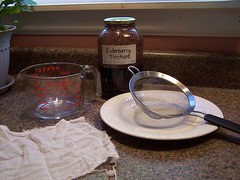
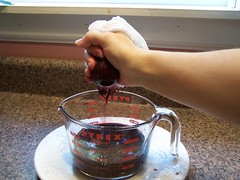
Now, for how to make the syrup:
I learned that I can mix equal parts of an herbal tincture with either honey or maple syrup to make a simple syrup. I chose not to use honey in case I ever needed to give some to the baby. So, I mixed equal parts of my elderberry tincture and real maple syrup. When using this syrup, I double the standard dosage. Typically, during an illness, I keep the sick person far away from any sugar. Shonda Parker (author of Mommy Diagnostics) taught me that any sugar (even healthy natural sugars like juice, sucanat or honey, etc.) decreases immune function for up to four hours after ingestion. But since we use Elderberry syrup primarily for prevention, and since the dosage is so small (for children: 30 drops or ~1 teaspoon per day) I determined that it was a small price to pay for the ease of getting herbs into my children. You see, this stuff tastes like candy-it is delicious! My children call it blueberry juice'.
'Blueberry juice' recipe: equal parts elderberry tincture and maple syrup. Store in the refrigerator.
There are tons of sites online that give more information about making herbal medicine, and I have learned some there. Some sites I use when researching herbs are:
this one for learning about the usage of certain herbs,
this one for learning how to make different forms of herbal products,
and this one for buying herbs and essential oils in bulk.
Several books that have taught me a lot are:
Mommy Diagnostics by Shonda Parker
Herbal Antibiotics by Stephen Harrod Buhner
The Complete Woman's Herbal by Anne McIntyre.
Have fun making your own medicine. (Although I hope you won't be needing it!)
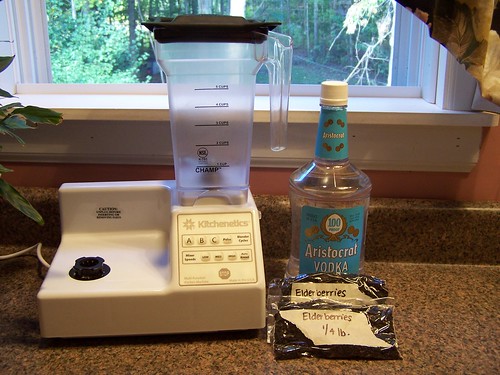
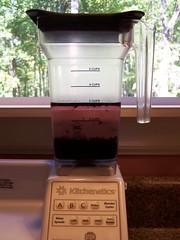
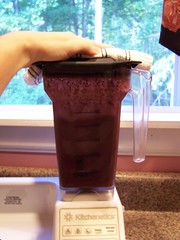
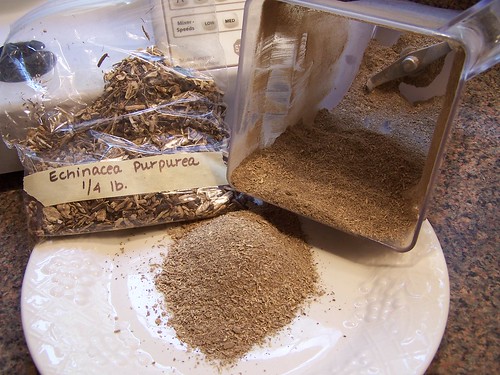
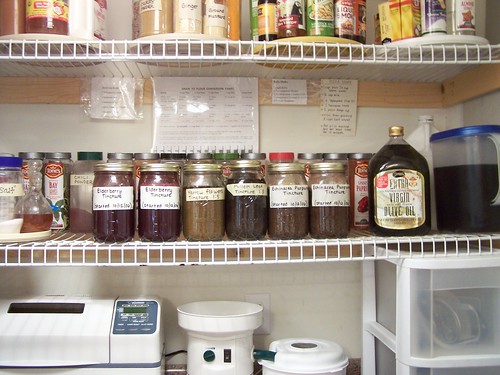
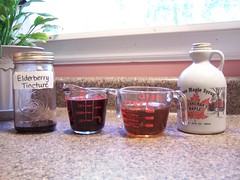
I love your site and everything I've read so far...I'd like to get involved in the study on Rebuilding the Church (not the right name, but you know what I'm saying, I'm sure.) I was wondering what herb or ticnture I can take for carpal tunnel or numbness of fingers?
ReplyDeleteI've been wanting to learn more about this and make some of my own things, but didn't have any idea where to start! Thanks for sharing this wonderful info! (your post and the links) :)
ReplyDeletewill you please let me know if you can make a tincture out of the elderberry flowers and whats the ratio. thank you very much for what your are doing! it's great!
ReplyDeleteElena~
ReplyDeleteYes, the flowers are great. For dried flowers, you'd just need 1/4 pound of dried herb for 16 ounces of alcohol to make a standardized tincture. Best Wishes in your tincture-making!
I made some elderberry tincture and need to know what the dose would be for children? The dose generally stated for adults in 2 tablespoons every 6 hours for 8-10 days. I do have grandkids though and I've been trying to find a correct dosage or how to amend the tincture for kids. This would not be for preventative, it would be in the event of coming down with the flu. Thank you so much, you have a great website!
ReplyDeleteHey, Julie! Does this mean you are still waiting for the twins' birth? I've been praying and checking in . . .
ReplyDeleteYes, you can use fresh elderberries, but a lot of people recommend that they be heated first. Some constituent of the berry tends to be a problem for some people if not heated. So the recommendation is to just cover with water and heat to boil and let set for 24 hours. When you press out the juice, then you can go on to make a syrup or a tincture. I do it both fresh and heated and have seen no adverse side effects. Hope you enjoy your elderberries.
ReplyDelete